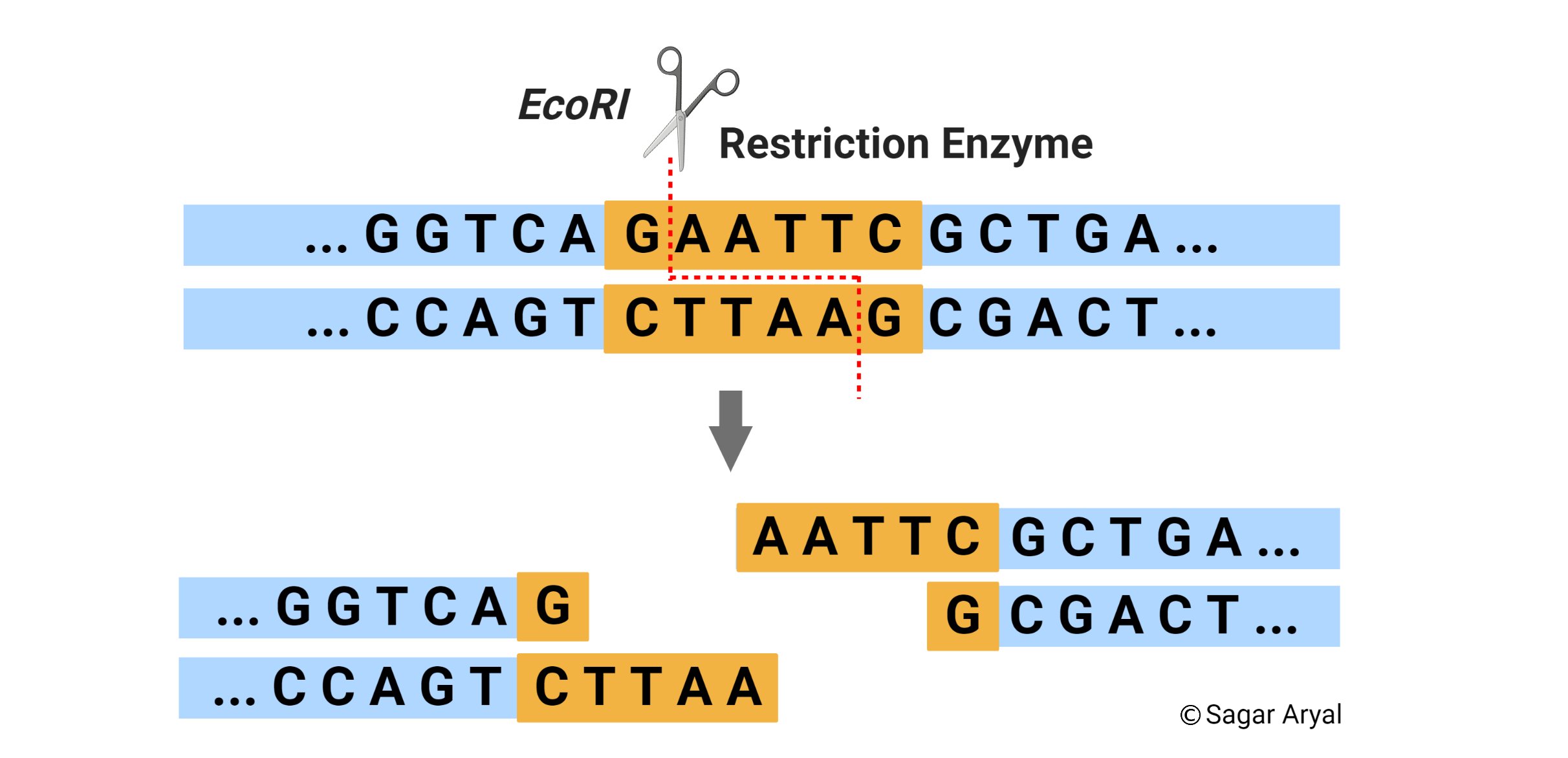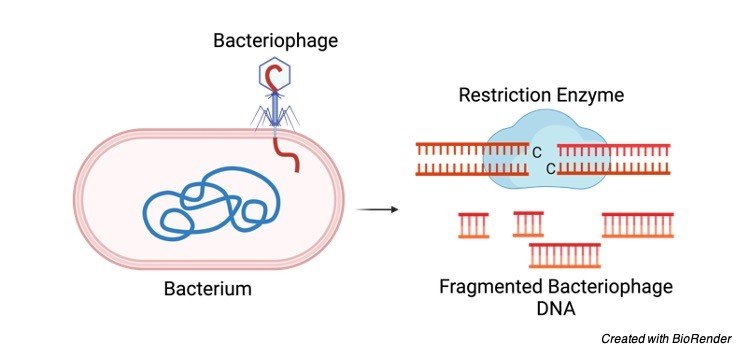Which of the Following Describe Restriciton Enzymes and Their Use
Similarly recombinant DNA technology which has equally strong ties with these extraordinary molecular tools had a revolutionary impact on molecular. Using what youve learned about restriction enzymes RE answer the following questions to determine the identity of unknown primers used for a PCR reaction with Lambda DNA 2 DNA.

Restriction Enzyme Restriction Endonuclease
Calculate the number of DNA products obtained after 4 cycles of PCR.

. The procedure for restriction cloning is quite simple. They do this by cleaving foreign DNA or repeated sequences of DNA. Types of Restriction Enzymes.
These are DNA molecules which consist of consist of genes or DNA fragments from two different organisms. In DNA fingerprinting restriction enzymes can be used to cut DNA to obtain the banding pattern of STR. Typically a small circular DNA molecule known as a plasmid obtained from bacteria is joined to another piece of DNA from another gene of.
Neoschizomers are the restriction enzymes which recognize the same site and have a different cleavage pattern. Restriction enzymes recognize and cut specific short sequences of DNA. It is also called Methylation enzyme.
1 Type I restriction enzymes. A restriction enzyme is a DNA-cutting enzyme that recognizes specific sites in DNA. Below is the map of a DNA and the cut sites for the RE EcoRI and Hindill along with the standard DNA ladder information these will be helpful in solving this puzzle.
Restriction enzymes are a type of protein that determines the size of a DNA molecule. Up to 10 cash back Abstract. This creates DNA fragments with one nucleotide strand that overhangs at the end.
Restriction enzymes have been identified in the early 1950s of the past century and have quickly become key players in the molecular biology of DNA. Restriction enzymes digest the plasmid you prepare an insert either from another plasmid or one you synthesized and last T4 DNA ligase ligates the plasmid and insert. Enzymes can be used to cut up and join DNA pieces together.
When a phage infects a bacterium it inserts its DNA into the bacterial cell so restriction enzyme also called restriction endonuclease a protein produced by bacteria that cleaves DNA at specific sites along the molecule. C both a and b. Restriction enzymes or restriction endonuclease enzymes are the protein produced by bacteria and archaeas which cut the DNA at specific recognition sites restricted sites.
Then you transform the ligated plasmid into a bacterium usually E. The reverse primer will have the following sequence. They allow researchers to obtain desired DNA fragments from genomic DNA.
These proteins helps bacteria and archaeas in defence against virus inva. DNA manipulation The many heuristic and applicative approaches employing restriction enzymes have proved fundamental for physical DNA mapping. Theyre found in bacteria which use the enzymes to digest invading DNA.
A bacterium uses a restriction enzyme to defend against bacterial viruses called bacteriophages or phages. Restriction enzymes recognise specific sequences in DNA and cut the DNA at these points. Here are some types of Restriction Enzymes.
A restriction enzyme are used to cut DNA molecule. If both sticky ends are cleansed by the same r enzyme they can facilitate insertion of foreign DNA into vector DNA. Today scientists recognize three categories of restriction enzymes.
The bacteria add methyl groups to their own DNA to protect them from digestion. C both a and b. Isoschizomers are the restriction enzymes which recognize and cleave at the same recognition site.
Forty years ago the scientists whose pioneering work had explored the activity and sequence specificity of these enzymes contributing to the definition of their enormous. If two DNA molecules have matching ends they can be joined by the enzyme DNA ligase. For example SmaI GGGCCC and XmaI GGGCCC are neoschizomers of.
7Which of the following are true regarding restriction enzyme. In the modified restriction endonuclease the recognition sequences of the DNA are modified by the methylation. DNA Ligase another enzyme is used to.
An extremely important use of restriction enzymes has been in the generation of recombinant DNA molecules. For example SphI CGTACG and BbuI CGTACG are isoschizomers of each other. Many restriction enzymes make staggered cuts at or near their recognition sites producing ends with a single-stranded overhang.
1 Introduction To Biological Concepts And Research 2 Life Chemistry And Water 3 Biological Molecules. Basic use of restriction enzymes. The whole process is known as molecular cloning.
They act as molecular scissors to cleave any piece of DNA at a specific site D. Restriction enzymes block the production of the old DNA to permit the new DNAs replication C. 512 describe the use of restriction enzymes to cut DNA at specific sites and ligase enzymes to join pieces of DNA together.
The Carbon Compounds Of Life 4 Cells 5 Membranes And Transport 6 Energy Enzymes And Biological Reactions 7 Cellular. Type I which recognize specific DNA sequences but make their cut at seemingly random sites. Molecular cloning is shown in figure 2.
May 1 2016 alissa Leave a comment. SmaI is an example of a restriction enzyme that cuts straight through the DNA strands creating DNA fragments with a flat or blunt end. The main steps of the production of recombinant DNA molecules are DNA isolation digestion with restriction enzymes ligation of the gene of interest to the vector and amplifying recombinant DNA molecule inside a host cell.
Other restriction enzymes like EcoRI cut through the DNA strands at nucleotides that are not exactly opposite each other. Modified restriction endonuclease plays a crucial role in the recognition or differentiation of the bacterial vs foreign DNA. Restriction enzymes are classified by their structure and the specificity of what they recognize.
Given that PCR can be used to modify sequences how could you use PCR to add a short specific DNA sequence to the end of a gene. Restriction enzymes are a type of endonucleases that can be used to cut double-stranded DNA at specific regions. Theyre called restriction enzymes because they restrict the growth of viruses B.
B restriction enzyme are used to construct restriction maps. The problem of course is that the devil is.

Restriction Enzymes Types Examples Studiousguy

Restriction Enzyme Definition Function And Types

Restriction Enzymes Powerpoint Slides

Restriction Enzymes Definition Types And Cut Patterns Youtube
Comments
Post a Comment